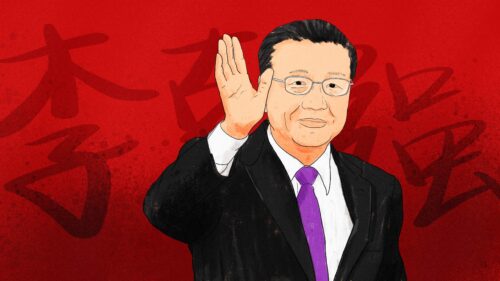We ask Tom Orlik: Can China’s economy really grow at 5.5% this year?
Tom Orlik, the chief economist for Bloomberg Economics, answers our questions about China’s economic growth and wild stock fluctuations in an age of uncertainty.

Tom Orlik, the chief economist for Bloomberg Economics, is the author of the book China: The Bubble That Never Pops. He is an erstwhile longtime resident of Beijing, was previously the chief Asia economist for Bloomberg, and before that headed the Wall Street Journal’s China economy coverage.
I talked to Tom by video call on March 17. This is an abridged, edited transcript of our conversation, part of my Invited to Tea interview series.
—Jeremy Goldkorn
I’d like to ask you first what you made of the 5.5% GDP growth target that was set at the recently concluded Two Sessions political meeting. Commentary on it that I could see seemed to be quite mixed. Some felt that it was ambitious given the world’s very uncertain situation right now with COVID, U.S. tensions, the war, and what some might describe as an austerity campaign in the form of Xi Jinping’s “common prosperity” concept. On the other hand, 5.5% is the lowest economic growth target since 1991. What do you make of it? And does it even matter given that some fear World War III is about to break out?
I’ll break the answer to that into two parts. The first part is about targets in general. Are they a good idea or not? And the second is about the 5.5% number.
The GDP target for China is much maligned. The standard narrative on it goes something like this: The government sets an artificial growth target which they have to achieve at all costs. And then, because everything is oriented around hitting that target, there’s not enough consideration to the quality of growth. And the result is an unbalanced economy, too much debt, too much investment, and ultimately a bubble that will one day pop. I don’t quite subscribe to that view. I think the challenge-
You are, after all, the author of The Bubble That Never Pops!
Right! The challenge for big developing economies is a coordination challenge. It’s making sure everyone’s pushing towards the same objective. And it’s also a confidence challenge. It’s making sure that everyone feels like they can undertake new projects, make big investments, launch ambitious plans with a reasonable expectation that they’re going to succeed.
The growth target helps achieve both of those objectives. The growth target sends a message to every local official, every business owner, every entrepreneur, every student wondering if they should invest more in their education or not. It says: “if you kick off this project, you’ve got a reasonable expectation of success because you’re in an economy which we guarantee you is going to be growing – and so there’s going to be demand for whatever you produce.”
So, there’s certainly negatives from the GDP target. It certainly creates distortions, but it also has that beneficial effect of sending a powerful signal to everyone across China, that the government is going to do its best to make sure that the economic future is bright and it’s worthwhile investing in themselves, investing in their businesses.
Now, is 5.5% the right number for 2022?
Well, it’s an ambitious number. China’s economy this year faces a considerable drag from the real estate sector. It faces a considerable drag from the “common prosperity” agenda and all that means for the big tech firms and the entrepreneurs. So, against that backdrop, getting to 5.5% is going to be tough, but by setting the number at an ambitious level, I think what the government does is make it more likely that they will get some growth. The target creates a self-fulfilling prophecy of success.
That has always been, I think, one of the things the Communist Party has done very well, to kind of give everyone the sense that growth is almost inevitable. So, you’d be crazy not to invest and work your butt off.
But, I guess what you’re saying is, the 5.5% target is ambitious, but it still makes sense…
It’s ambitious for a reason. Let’s imagine a counterfactual where the Chinese government says, “we’re not setting a target this year or this year”, or “we’re targeting 2% growth.” What signal does that send? That sends a signal that the wheels are coming off the wagon, that if you plan a new bridge or a new factory, or you invest in some new cloud capacity, or you decide that you’re going to pay for yourself to go to business school, then you’re making a mistake. Because the growth isn’t going to be there so the demand for your products or your skills isn’t going to be there.
So, if at a moment of weakness and uncertainty for the Chinese economy, you back away from setting targets, or you set a ‘realistically’ low target, you create a self-fulfilling prophecy of failure. If you set a ambitiously high target, you risk adding to those distortions in the economy, you risk adding to the overdependence on debt, the overdependence on investment, but you also hope that you’re creating a self-fulfilling prophecy of success.
Are you prepared to answer whether you think this ambitious target is going to be effective this year?
In the face of an extremely infectious and deadly disease, governments all over the world have seen their plans thrown into disarray. So in 2020, even though China did much better than most other economies around the world and did grow that year, growth was I think around 2%, and they were aiming for 6%. And in 2022, I mentioned the real estate challenge, I mentioned the “common prosperity” challenge. There’s also a COVID challenge. We’ve seen Shenzhen just locking down. We’ve seen Jilin locking down. The virus is clearly a variable, which even Beijing is not able to control and could potentially knock the best laid plans off course.
I think the other big variable, which I don’t see as such an enormous risk for China, but is certainly there, is what happens with Russia’s invasion of Ukraine. I would put a low probability on this happening, but the concern for some analysts is if China is seen as aggressively lining up on the wrong side of this conflict, then perhaps some of the sanctions which are currently hammering Russia’s economy could create a problem for China as well.
But you think that’s a relatively low probability?
I’d put a low probability on that, firstly because I think China will be cautious to stay on the right side of the line, and secondly because I think that the costs for the U.S. and Europe of sanctioning China would be significant. You’ve seen that Europe has been reluctant to sanction Russian energy because the cost to the European economy of doing so is very high. A similar logic applies to sanctioning China. China is the critical node in the supply chain for everything from textiles to electronics. Sanctions which were meaningful enough to have a negative impact on Chinese growth would also be negative for the U.S. and for Europe.
Makes sense. So, that’s the big picture? What about this crazy week on the Chinese markets we’ve had? They began dropping on Monday with investors spooked perhaps maybe by the Russian invasion of Ukraine, by rising COVID numbers, by renewed regulatory rumbles in Beijing, especially against Tencent, and some media reporting about this.
But then yesterday, the Financial Stability and Development Committee of the State Council held a meeting and Liú Hè 刘鹤, who’s maybe the closest thing China has to an economic tsar, signaled government support for markets. And almost instantly the markets turned around.
Are these animal spirits? People are just going crazy? What to make of it? Is there any rhyme or reason in it?
I think there are four factors which were hitting Chinese stocks.
So firstly, you’ve got real estate. Real estate is the single biggest contributor to China’s growth. By some estimates, it accounts for around 25%, 30% of GDP. And real estate’s in big trouble. It’s over-invested, it’s over-leveraged, it’s over-capacity. And with the default of Evergrande last year, the government signaled that it was going to start taking these problems seriously. And taking these problems seriously means — at least in the short term — a significant blow to profits for property developers and all the other bits of the economy, which are tied to them.
Second factor is the Common Prosperity agenda and all that means for the tech darlings, the Alibabas, Tencents, Meituans, Didis of the world. At its heart, the Common Prosperity agenda is about addressing the problem of inequality in China. Now, we can argue about whether from a broad economic and societal perspective that’s a good idea or not, but if you’re a stock investor and you see the government announcing a big initiative, which essentially means taking profits from the company you invested in and giving it to workers and their families, that’s clearly a negative for the value of the stock.
Third factor, COVID. China looked incredibly effective at controlling COVID in 2020. In 2022, the picture looks a bit different and pretty challenging. Shenzhen is arguably the most important city for China’s economy – you have the port, finance, technology, manufacturing, a massive population. And Shenzhen is currently locked down. For investors, that’s a frightening signal of where things might go.
A Foxconn plant in Shenzhen suspended manufacturing, right? So that would be particularly scary for anyone who cares about the Chinese economy?
Well, indeed. If you want to send palpitations through the heart of global investors, just tell them something’s happening to Apple’s supply chain. So a Foxconn factory shutting down in Shenzhen is the sort of thing which sends a jolt through the markets.
And then the last factor, and we’ve already talked about how it’s probably the lowest risk, but certainly it’s there, is the concern that Russia’s invasion of Ukraine could somehow create negative spillovers for China, perhaps because China finds itself at the wrong end of sanctions.
So you had all four of these factors, you’ve got real estate, you’ve got Common Prosperity, you’ve got COVID risk, you’ve got the Ukraine risk, all weighing on stocks.
But we’ve now heard China moving to address all of those concerns. And addressing them at a high level. Liu He, as you mentioned, the closest that China has to an economic tsar, came out and said, “Okay, we’re going to stabilize property, we’re going to ease up on regulations, and the PBOC is going to have more stimulus”. So all of these things together took a lot of the fear out of China stocks and drove that enormous turnaround that we saw this week.
The question in the weeks ahead is, well, that was the rhetoric, what’s the reality going to be? Are we going to see actual policies coming in the next few weeks, which help put a floor under property, which deliver increased stimulus from the PBOC and so on?
That ties into my last question, which is about an article that you and your colleague Eric Zhu published on February 10. In it you ask when China will outstrip the U.S. to claim the top spot in the world economic rankings.
For Beijing, the two of you wrote, “It would be convenient if everyone viewed that transition as inevitable and imminent. The reality is, it’s anything but a debt crisis, demographic drag and international isolation could all keep China stuck in perpetual second place.”
And you sketch out three scenarios for that, a base case where China and the U.S. continue on their current trajectories. And then there’s the scenario where China slows down, where it becomes unclear if China could overtake the U.S., but it’s not doing terribly. And then finally there is the case of some kind of financial crisis where China obviously slows down enough to fall way below the U.S.
That was published on February 10, exactly two weeks before the Russian invasion of Ukraine. From what you’ve said already, I don’t think things look that different to you now than they did before the invasion, but with the benefit of a month’s hindsight, has anything changed?
Right now GDP per capita in China is about a third of the level of the United States. Why is that? Well, it’s a reflection of education. It’s a reflection of the technology which workers have access to. It’s a reflection of the capital stock workers have access to. And it’s a reflection of how productive China is, how clever they are at bringing workers and technology and capital together.
But what we saw with Japan and Korea is that economies which follow a state-driven development model can catch up to the United States in terms of GDP per capita pretty quickly.
Japan caught up most of the way. China’s population is four times as big as that of the United States. If they catch up a bit more, they’ll have a bigger economy. So, from that perspective, it feels like the base case of China overtaking the United States is pretty robust and difficult to argue with.
At the same time, there are some really big things that could go wrong. One of them is that China could have a financial crisis, which triggers a recession, and then puts China on a much slower growth path as they deal with the aftermath. A financial crisis in China isn’t our base case. But with the Evergrande default and with the continued problems in the real estate sector, we’ve had a reminder that China is not immune to the risk.
Another is international isolation – being cut off from global trade and technology ties. Starting with the Trump trade war, elements of that risk are already playing out. Debates in the U.S. and Europe about how much they want to cooperate with China, whether there should be sanctions on Chinese technology firms, whether Chinese students should be allowed to come and study in the United States, show how ties could continue to fray. Again, not our base case, but in a risk scenario, China could find itself cut off from learning opportunities from the rest of world, and that would put the economy on a slower growth path.
Invited to Tea with Jeremy Goldkorn is a weekly interview series. Previously:
It’s a crazy world out there! Rui Ma on this week’s wild stock market fluctuations in China






